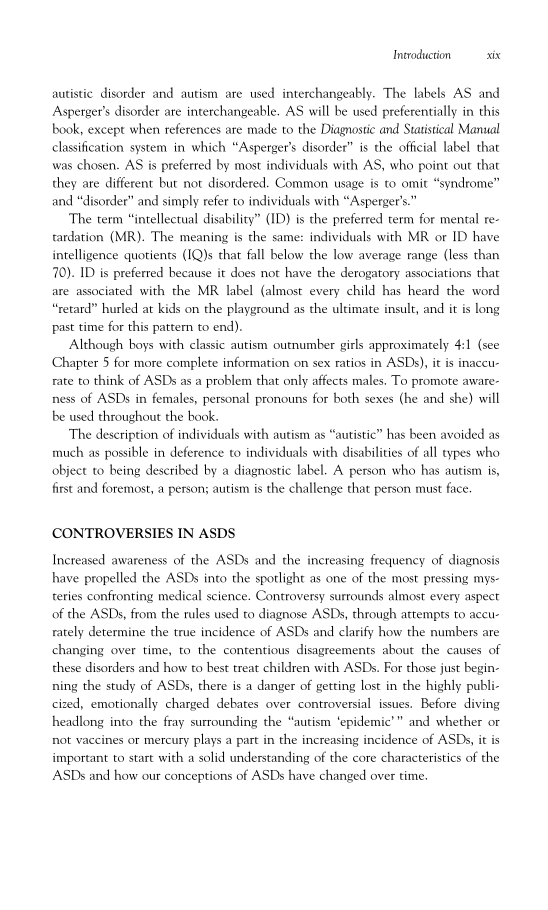autistic disorder and autism are used interchangeably. The labels AS and Asperger’s disorder are interchangeable. AS will be used preferentially in this book, except when references are made to the Diagnostic and Statistical Manual classification system in which ‘‘Asperger’s disorder’’ is the official label that was chosen. AS is preferred by most individuals with AS, who point out that they are different but not disordered. Common usage is to omit ‘‘syndrome’’ and ‘‘disorder’’ and simply refer to individuals with ‘‘Asperger’s.’’ The term ‘‘intellectual disability’’ (ID) is the preferred term for mental re- tardation (MR). The meaning is the same: individuals with MR or ID have intelligence quotients (IQ)s that fall below the low average range (less than 70). ID is preferred because it does not have the derogatory associations that are associated with the MR label (almost every child has heard the word ‘‘retard’’ hurled at kids on the playground as the ultimate insult, and it is long past time for this pattern to end). Although boys with classic autism outnumber girls approximately 4:1 (see Chapter 5 for more complete information on sex ratios in ASDs), it is inaccu- rate to think of ASDs as a problem that only affects males. To promote aware- ness of ASDs in females, personal pronouns for both sexes (he and she) will be used throughout the book. The description of individuals with autism as ‘‘autistic’’ has been avoided as much as possible in deference to individuals with disabilities of all types who object to being described by a diagnostic label. A person who has autism is, first and foremost, a person autism is the challenge that person must face. CONTROVERSIES IN ASDS Increased awareness of the ASDs and the increasing frequency of diagnosis have propelled the ASDs into the spotlight as one of the most pressing mys- teries confronting medical science. Controversy surrounds almost every aspect of the ASDs, from the rules used to diagnose ASDs, through attempts to accu- rately determine the true incidence of ASDs and clarify how the numbers are changing over time, to the contentious disagreements about the causes of these disorders and how to best treat children with ASDs. For those just begin- ning the study of ASDs, there is a danger of getting lost in the highly publi- cized, emotionally charged debates over controversial issues. Before diving headlong into the fray surrounding the ‘‘autism ‘epidemic’ ’’ and whether or not vaccines or mercury plays a part in the increasing incidence of ASDs, it is important to start with a solid understanding of the core characteristics of the ASDs and how our conceptions of ASDs have changed over time. Introduction xix
Document Details My Account Print multiple pages
Print
You have printed 0 times in the last 24 hours.
Your print count will reset on at .
You may print 0 more time(s) before then.
You may print a maximum of 0 pages at a time.
















































































































































































































































































